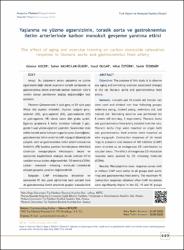| dc.contributor.author | Koçer, Günnur | |
| dc.contributor.author | Nasırcılar Ülker, Seher | |
| dc.contributor.author | Olgar, Yusuf | |
| dc.contributor.author | Öztürk, Nihal | |
| dc.contributor.author | Özdemir, Semir | |
| dc.date.accessioned | 2023-11-30T06:55:14Z | |
| dc.date.available | 2023-11-30T06:55:14Z | |
| dc.date.issued | 2020 | en_US |
| dc.identifier.uri | https://www.scopus.com/record/display.uri?eid=2-s2.0-85101506420&origin=resultslist&sort=plf-f&src=s&nlo=&nlr=&nls=&sid=20c4fe371b9b908d4f7e419f791331ff&sot=aff&sdt=cl&cluster=scofreetoread%2c%22all%22%2ct&sl=72&s=AF-ID%28%22Alanya+Alaaddin+Keykubat+University%22+60198720%29+AND+SUBJAREA%28MEDI%29&relpos=165&citeCnt=0&searchTerm= | |
| dc.identifier.uri | https://hdl.handle.net/20.500.12868/2449 | |
| dc.description.abstract | Amaç: Bu çalışmanın amacı yaşlanma ve yüzme
egzersizine bağlı olarak sıçanların torasik aortasında ve
gastroknemius iletim arterinde karbon monoksit (CO)’e
verilen damar yanıtlarının değişip değişmediğini test
etmektir.
Yöntem: Çalışmamızda 4 aylık genç ve 24 aylık yaşlı
Wistar dişi sıçanlar kullanıldı. Sıçanlar rastgele gençsedanter (GS), genç-egzersiz (GE), yaşlı-sedanter (YS)
ve yaşlı-egzersiz (YE) olmak üzere dört gruba ayrıldı.
Egzersiz gruplarına 8 hafta süresince haftada 5 gün,
günde 1 saat yüzme egzersizi yaptırıldı. Sıçanlardan izole
edilen torasik aorta halkaları organ banyosu düzeneğinde,
gastroknemius iletim arteri ise telli miyograf düzeneğinde
çalışıldı. Aort ve gastroknemius iletim arteri halkalarının
fenilefrin (PE) kasılma yanıtları hemoksijenaz inhibitörü
chromium mesoporphyrin inkübasyonu öncesi ve
sonrasında kaydedilerek endojen olarak üretilen CO’in
vasküler tonusa katkısı değerlendirildi. CO donörü (CORM;
carbon - monoxide - releasing - molecule) kullanılarak
ekzojen gevşeme yanıtları değerlendirildi.
Bulgular: CrMP inkübasyonu öncesinde ve
sonrasında PE doz yanıt eğrilerinde hem aortada hem
de gastroknemius iletim arterinde gruplar arasında fark yoktu. CrMP inkübasyonu sonrasında alınan maksimum
PE kasılma yanıtları aort halkalarında GE, YS ve YE
gruplarında anlamlı olarak daha yüksekti (p<0,05),
gastroknemius iletim arterlerinde ise sadece GS ve GE
gruplarında anlamlı olarak yüksekti (p<0,01). CORM’a
verilen maksimum gevşeme yanıtlarında gastroknemius
iletim arterinde gruplar arasında fark yoktu. Aorta
halkalarında ise maksimum CORM gevşeme yanıtları yaşlı
gruplarda anlamlı olarak daha düşüktü (p<0,05).
Sonuç: Çalışmanın sonuçları; gastroknemius iletim
arterinde CO yanıtlarına egzersiz ve yaşlanmanın etkisi
olmadığını, Aorta halkalarında ise CO gevşeme yanıtının
yaşlanmayla birlikte azaldığını ve egzersizin CO gevşeme
yanıtını hem yaşlı hem de genç sıçanlarda arttırıcı bir
katkısının olmadığını göstermektedir. | en_US |
| dc.description.abstract | Objective: The purpose of this study is to observe
any aging and swimming exercise associated changes
in the rat thoracic aorta and gastrocinemius feed
artery.
Methods: 4-month and 24-month old female rats
were used and divided into four following groups:
sedentary young, trained young, sedentary old, and
trained old. Swimming exercise was performed for
8 weeks (60 min/day, 5 days/week). Thoracic Aorta
and gastrocinemius feed artery isolated from the rats.
Thoracic Aorta rings were mounted on organ bath
and gastrocinemius feed arteries were mounted on
wire myograph. Contraction responses of all vessel
rings in presence and absence of HO inhibitor (CrMP)
were recorded as an endogenous CO contribution to
vascular tonus. The effect of exogenous CO relaxation
response were assesed by CO releasing molecule
(CORM).
Results: Phenylephrine dose- response curves with
or without CrMP were smilar in all groups both aortic
rings and gastrocnemius feed artery. The maximum PE
contraction responses obtained after CrMP incubation
were significantly higher in the GE, YS and YE groups (p <0.05) in the aortic rings, and only significantly
higher in the GS and GE groups in the gastrocnemius
feed arteries (p <0,01). There was no differences in the
maximum vasodilatation response of CORM reported
for all groups in gastrocnemius feed artery. However,
in the old groups CORM Emax values were established
significantly lower than that the young groups in the
aortic rings (p<0,05).
Conclusion: As a results of this study; exercise
and aging have no effect on CO responses in the
gastrocnemius feed artery. But the CO relaxation
response is decreased by aging in the thoracic aorta of
elderly rats and exercise does not have an enhancing
contribution for CO relaxation response in both old and
young rats. | en_US |
| dc.language.iso | eng | en_US |
| dc.relation.isversionof | 10.5505/TurkHijyen.2020.54289 | en_US |
| dc.rights | info:eu-repo/semantics/openAccess | en_US |
| dc.subject | Karbon monoksit | en_US |
| dc.subject | Hemoksijenaz | en_US |
| dc.subject | Vasküler tonus | en_US |
| dc.subject | Aorta | en_US |
| dc.subject | Gastroknemius iletim arteri | en_US |
| dc.subject | Carbon monoxide | en_US |
| dc.subject | Hemo oxygenase | en_US |
| dc.subject | Vascular tonus | en_US |
| dc.subject | Gastrocnemius feed artery | en_US |
| dc.title | The effect of aging and exercise training on carbon monoxide relaxation response in thoracic aorta and gastrocnemius feed artery | en_US |
| dc.title.alternative | [Yaşlanma ve yüzme egzersizinin, torasik aorta ve gastroknemius iletim arterlerinde karbon monoksit gevşeme yanıtına etkisi] | en_US |
| dc.type | article | en_US |
| dc.contributor.department | ALKÜ, Fakülteler, Sağlık Bilimleri Fakültesi, Fizyoterapi ve Rehabilitasyon Bölümü | en_US |
| dc.identifier.volume | 77 | en_US |
| dc.identifier.issue | 4 | en_US |
| dc.identifier.startpage | 449 | en_US |
| dc.identifier.endpage | 458 | en_US |
| dc.relation.journal | Turk Hijyen ve Deneysel Biyoloji Dergisi | en_US |
| dc.relation.publicationcategory | Makale - Uluslararası Hakemli Dergi - Kurum Öğretim Elemanı | en_US |


















